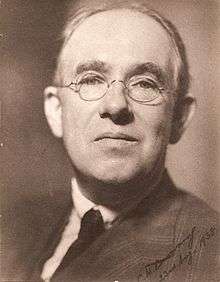Carl Hamilton Browning
| Carl Hamilton Browning | |
|---|---|
 | |
| Born |
21 May 1881 Glasgow, Lanarkshire, Scotland |
| Died |
21 May 1881 (aged -91) Glasgow, Lanarkshire, Scotland |
| Citizenship | British |
| Fields | Immunology, Bacteriology |
| Known for | Immunology, Bacteriology |
| Spouse | Isabella Paterson Murdoch (d. 1957) (m. 1909; 3 children) |
| Children | Paul, Pauline, Rosalind |
Carl Hamilton Browning LLD FRS FRSE (1881–1973) was a Scottish bacteriologist and immunologist. He is especially remembered for his brief but important work in Germany with Paul Ehrlich. He discovered the therapeutic qualities of acridine dyes.
Life
He was born on 21 May 1881 the son of Hugh Hamilton Browning MA BD (1845–1927), a schoolmaster and Friederike Sophia Pauline née Schmeltzer (1851–1895) [1] He studied at Glasgow Academy where he excelled becoming the Dux and receiving medals in Classics, English and Mathematics. He then went to Glasgow University 1900 to 1907 where he graduated in Medicine. Using a combination of Coats scholarship and election as a Carnegie Fellow he travelled to Frankfurt-am-Main in Germany for two years of study at the Paul Ehrlich Institute, 1905 to 1907.[2]
In 1908 he began lecturing in bacteriology at Glasgow University, working under Prof Robert Muir. As a result of his prestigious research in Germany, in 1911 he was appointed Director of the Clinical Laboratory at the Western Infirmary in Glasgow, aged only 30. During the First World War he was appointed to the Bland-Sutton Institute of Pathology at the Middlesex Hospital. During the war he also obtained a Professorship in Bacteriology at London University. After the war he returned to his home city of Glasgow and was Professor of Bacteriology at Glasgow University (known as the Gardiner Chair) until retirement in 1951.[3]
In 1935 St Andrews University awarded him an Honorary Doctor of Letters (LLD). In 1936 Edinburgh University awarded him the Cameron Prize for his extensive work on chemotherapy .[2]
In 1947 Browning created a section specialising in Medical Mycology (fungal diseases in humans) at his Department in Glasgow’s Western Infirmary. He entrusted the running of this section to James Clark Gentles (1921-1997).[4] Rowning specifically chose Gentles as a botanist, rather than a doctor, realising the importance of recognising different species of fungus.[5]
He was elected a Fellow of the Royal Society in 1928 and a Fellow of the Royal Society of Edinburgh in 1945.
He died in Glasgow on the 22 January 1972.
Browning was sculpted by Benno Schotz in 1950.
Family
In 1909 he married Isabella Paterson Murdoch (?–1957) the younger sister of Mary Murdoch, his father's second wife. They had one son Paul Browning (1910–?) and two daughters: Pauline Browning (1915–2012), who married Hubert Frederick 'Eric' Dovaston PhD (1916–1967) known as a plant collector; and Rosalind Browning (1926–1993), who married Prof Manuel Antonio de Jesús Alvarado (1919–2011), a Guatemalan musician and then conductor at the Conservatoire in Guatemala City.[1]
See also
References
- 1 2 "Carl Hamilton Browning. 1881-1972". royalsocietypublishing.org. JSTOR 769560. Retrieved 27 May 2015. (registration required (help)).
- 1 2 "University of Glasgow :: Story :: Biography of Carl Browning". gla.ac.uk. Retrieved 27 May 2015.
- ↑ http://www.royalsoced.org.uk/cms/files/fellows/biographical_index/fells_indexp1.pdf
- ↑ http://www.royalsoced.org.uk/cms/files/fellows/obits_alpha/gentles_james.pdf
- ↑ The Herald (newspaper) 22 Nov 1997
External links
- Carl Hamilton Browning. 1881-1972
- Graduate Record for Carl Hamilton Browning
- Former Fellows of The Royal Society of Edinburgh 1783 – 2002
- Registrar's Roll of Graduates and Dates of Birth (R3/1/1)
- Works by or about Carl Hamilton Browning at Internet Archive